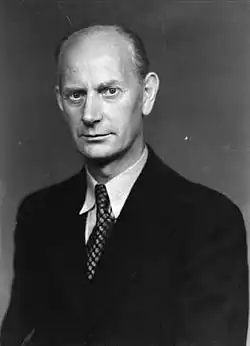1957 Norwegian parliamentary election|
|
|
| | First party | Second party | Third party | | |  |  |  | | Leader | Einar Gerhardsen | Alv Kjøs | Bent Røiseland | | Party | Labour | Conservative | Liberal | | Last election | 46.7%, 77 seats | 18.9%, 27 seats | 10.0%, 15 seats | | Seats won | 78 | 29 | 15 | | Seat change |  1 1 |  2 2 |  0 0 | | Popular vote | 865,675 | 352,755[a][b] | 177,291[b] | | Percentage | 48.3% | 21.7%[a][b] | 10.5%[b] |
| | | Fourth party | Fifth party | Sixth party | | | .jpg) | |  | | Leader | Per Borten | Einar Hareide | Emil Løvlien | | Party | Farmers' | Christian Democratic | Communist | | Last election | 9.3%, 14 seats, | 10.5%, 14 seats | 5.1%, 3 seats | | Seats won | 15 | 12 | 1 | | Seat change |  1 1 |  2 2 |  2 2 | | Popular vote | 200,237[a] | 183,243 | 60,060 | | Percentage | 9.9%[a] | 10.2% | 3.4% | |
 Largest bloc and seats won by constituency |
|
Parliamentary elections were held in Norway on 7 October 1957.[1] The result was a victory for the Labour Party, which won 78 of the 150 seats in the Storting. As a result, the Gerhardsen government continued in office.
This was the last time a single party won a majority of seats on its own in a Norwegian election.
Newspaper endorsements
Results
 |
|---|
| Party | Votes | % | Seats | +/– |
|---|
| Labour Party | 865,675 | 48.33 | 78 | +1 |
| Conservative Party | 301,395 | 16.83 | 25 | +2 |
| Christian Democratic Party | 183,243 | 10.23 | 12 | –2 |
| Liberal Party | 171,407 | 9.57 | 15 | 0 |
| Farmers' Party | 154,761 | 8.64 | 14 | +1 |
| Communist Party | 60,060 | 3.35 | 1 | –2 |
| Farmers'–Conservatives[a] | 45,476 | 2.54 | 4 | – |
| Liberals–Conservatives[b] | 5,884 | 0.33 | 1 | – |
| Norwegian Social Democratic Party | 2,855 | 0.16 | 0 | New |
| Liberal People's Party | 249 | 0.01 | 0 | New |
| Progress Party | 105 | 0.01 | 0 | New |
| Wild votes | 18 | 0.00 | – | – |
| Total | 1,791,128 | 100.00 | 150 | 0 |
|
| Valid votes | 1,791,128 | 99.50 | |
|---|
| Invalid/blank votes | 9,027 | 0.50 | |
|---|
| Total votes | 1,800,155 | 100.00 | |
|---|
| Registered voters/turnout | 2,298,376 | 78.32 | |
|---|
| Source: Nohlen & Stöver |
Voter demographics
| Cohort | Percentage of cohort voting for |
| Ap | H | V | KrF | Sp | Others |
| | | | | | |
| Total vote | 48.3% | 21.7% | 10.5% | 10.2% | 9.9% | |
| Gender |
| Female | 47.8% | 15.7% | 9.6% | 13.2% | 9.6% | |
| Male | 48.9% | 17.8% | 9.6% | 7.4% | 7.7% | |
| Age |
| 18–30 years old | 58.5% | 17.1% | 8.3% | 5.7% | 5.7% | |
| 30-59 years old | 48.5% | 15.5% | 10.3% | 9.5% | 8.8% | |
| 60 years old and older | 40.7% | 20.3% | 8.3% | 15.8% | 10.8% | |
| Work |
| Low income | 47.2% | 13.1% | 7.6% | 14% | 13.1% | |
| Average income | 59.6% | 10.1% | 8.7% | 8.7% | 7% | |
| High income | 38% | 28.7% | 12.3% | 7.6% | 5.3% | |
| Education |
| Primary school | 57.8% | 9.5% | 8.1% | 10.5% | 7.4% | |
| High school | 30.7% | 24.9% | 13.6% | 10% | 13.9% | |
| University/college | 16.4% | 62.7% | 10.4% | 9% | 1.5% | |
| |
| Source: Norwegian Institute for Social Research[4][5][6] |
Seat distribution
Notes
- ^ The joint list of the Farmers' Party and Conservative Party won four seats, three of which were taken by the Conservative Party and one by the Farmers' Party.[3]
- ^ The joint list of the Liberal Party and Conservative Party won one seat, taken by the Conservative Party.[3]
References




.jpg)
